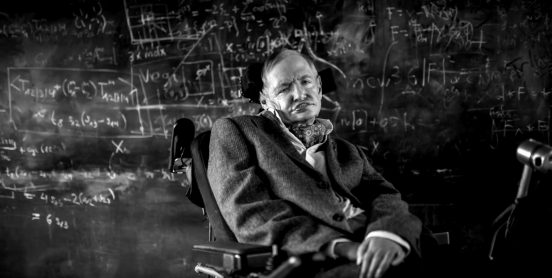“Religion was an early attempt to answer the questions we all ask, why are we all here, where did we come from? Nowadays science provides better and more consistent answers, but people will always cling to religion because it gives comfort, and they do not trust or understand science” (Hawking, 2018).
When listening to this interview with Steven Hawking which sadly turned out to be one of his last, I couldn’t help but think of the observations of Bolter when he described the arduous journey from scroll to codex and the hesitations of the church to adopt the new medium. One of the largest challenges, as shown in the humorous sketch video “the Medieval Helpdesk,” was overcoming the hurdles that came with understanding how a new medium functions in its relation to texts. In many ways understanding the facets of a new medium is virtually the same as learning about science and of a new existence, a new universe, and a new definition of what it means to human.
As humans who are born and raised within a certain environment we are often hesitant to ‘advance’ as it signifies that everything we have ever known and loved was perhaps inferior or even wrong. Indeed, as Neil Degrasse Tyson points out in his documentary Cosmos, there are strong human sentiments and even hostilities towards what we might call “progress.” Giordano Bruno, an Italian monk, was fascinated by outer space and the discussions of Copernicus about how we are not only living on a heliocentric planet (not in a geocentric universe as people believed at the time) but that space is infinitely larger than we had ever imagined. Being a devoutly religious man, he suggested that these new discoveries proved that God was even more amazing than anyone ever could have imagined, and that God was responsible for the creation of not only our Earth but the entire universe replete with other inhabited planets. In the face of this suggestion that traditional beliefs of God and his domain’s were both incorrect and small-minded, the church banished Giordano from Italy and soon thereafter he was laughed out of churches all over Europe. Eventually he was tried by the Roman Catholic Church and executed for his believes.
This resistance to change driven by a molotov cocktail of fear of the unknown and mentally ingrained bias towards things that known and comfortable is exactly the same as that which was observed by Bolter when he described the introduction of the codex and Annie Proulx’s bold statement that “no one is going to read a novel on a twitchy little screen. Ever” (Bolter, 2000). Of course, not many years later Proulx would likely be eating her words (perhaps even digitally) as a huge chunk of society migrated to their Amazon Kindles, tablets and smartphones to read the latest books.
Drawing once again on the science perspective, Bill Nye (the science guy) has stated on multiple occasions that this phenomenon where we cling to what we know and believe (particularly in regards to religion) because it essentially defines us, despite the fact that these things might not be factual or may even be harmful to us and the entire human race, is called “cognitive dissonance” and is highly destructive and counter-productive. I myself know of many people who prefer to read and write on paper, print out all of the worksheets for their classes, and try to come in contact with paper as much as possible because they like the ‘feel’ of it. I can totally relate to this, but at the same time I know that the demand which necessitates the process to produce this paper is directly resulting in deforestation, desertification, species vital to the ecosystems of our planet going extinct, and other massive contributions to global. Couple this with the fact that in almost every single way digital texts are superior to paper-based texts in terms of dissemination and availability and there is very little reason to cling to paper– save for cognitive dissonance.
Even in the midst of the transition from paper books to digital resources we are already well on the way towards the next transition where text as we know it may disappear entirely. Bolter notes that with the development of VR technologies where text becomes more and more visual and embodied that traditional ‘written’ forms of text might be done away with entirely. Instead text would become visual stimuli and be transferred via cerebral networks of information which may exist as a purely electronic impulse-based text. All I know is that I can feel a twinge of cognitive dissonance in me already!
References:
Bolter, Jay David. (2001). Writing space: Computers, hypertext, and the remediation of print [2nd edition]. Mahwah, NJ: Lawrence Erlbaum.
Braga, B., Pope, B., Druyan, A., Hanich, L., Holtzman, S., Soter, S., Silvestri, A., … Twentieth Century Fox Home Entertainment Ltd.,. (2014). Cosmos: A spacetime odyssey.
Tyson, N.D. (2018). The Universe and Beyond with Steven Hawking. Startalk Radio. Retrieved 22 June 2018 from https://www.youtube.com/watch?v=TdjAJeUy0zM
Watercutter, A. (2018, February 01). Bill Nye Says Climate Change Deniers Have a Bad Case of Cognitive Dissonance. Retrieved 22 June 2018 from https://www.wired.com/2017/04/bill-nye-says-climate-change-deniers-bad-case-cognitive-dissonance/







Stephanie Kwok
July 1, 2018 — 9:03 am
Hi Adam,
Great post, I really enjoyed watching the sketch of “the Medieval Helpdesk” also. It made me think about the frequent interactions I have with my own parents and coworkers teaching them how to use their digital devices, and I had a good chuckle. Your post resonated with me greatly as I find that I also feel a discomfort or fear with learning new technologies at times. I worry about the day that my basic understanding of technologies is surpassed, and I am no longer able to intuitively comprehend a technology’s usage or process. What is seemingly instinctive to me now may not be relevant in several years at the rate that technology is transforming, and although I consider myself to be a digital native, there are already many things online I am unable to comprehend. However, this learning, growing, and transformative experience is indeed a part of what it means to be human. It is reflective of our culture’s ambitions to improve upon what we are able to do and accomplish now, similar to Bolter’s belief that the development of modern writing technologies reflects our culture’s ambitions for writing (2001, p. 16).
I also enjoyed how you discussed cognitive dissonance to be “highly destructive and counter-productive”. I also avoid the use of physical paper due to the negative effects upon the environment, and hate buying books and textbooks due to the fact that they take up so much storage space. As a teacher, I try my best to store all my lesson plans, resources, and documents on my computer and portable hard drive, in order to avoid clutter and waste. That being said, my co-worker recently lent me a couple of old books that she recommended me to read, and I found it to be such a nostalgic thrill to sit, ‘unplugged’ from my laptop, interacting with the physical books in hand. Such a difference to be completely offline, reading leisurely for enjoyment without a screen in front me!
Bolter, Jay David. (2001). Writing space: Computers, hypertext, and the remediation of print [2nd edition]. Mahwah, NJ: Lawrence Erlbaum.
adam sheard
July 6, 2018 — 4:19 pm
Haha, yes! It is very difficult for us to fight the feelings of nostalgia. However, in your case it might even be feelings of fascination and novelty that drive your current paper-back reading enjoyment.
david nelson
July 4, 2018 — 5:15 pm
You had me at Neil Degrasse Tyson and Bill Nye!
I thoroughly enjoyed your post and after a quick viewing of Bill Nye talking about cognitive dissonance, I instantly thought of Trump. Anyways though, not the point of my post! Ha
Thinking about cognitive dissidence within schools, and more specifically staff, I began thinking about some of my coworkers that shutter at the thought of a new technology or initiative. There is so much change within the leaders of educational departments and school boards that once an idea comes to fruition, it takes multiple years for that plan to be passed down to the teachers. Because it has taken numerous years, many of these people in power are up for reelection which then starts the process over again. This begins this cycle over again with the new leader’s new learning theories and directions with technology. I can understand why the veteran teachers are hesitant in adopting these new “great ideas.” Many veteran teachers know that if they just wait out this “great idea” another idea will take over within a few years and they will have to redesign their lesson plans again. This seems to be commonplace for many schools and maybe a problem directly related to the ease that information can be passed on through the internet. A threat to one’s worldview is scary for many, however, the real problem here is that new worldviews are being thrust upon us at such an alarming rate, that we just cannot sift through them all to find the ones that truly work for us. I think of the multiple reports that breakfast is bad for you, oh wait, it is the most important, oh wait, you should wait 12 hours and then eat breakfast, etc.
adam sheard
July 6, 2018 — 4:11 pm
Hello David!
I totally agree with you. It is as if we are caught in a kind of vicious cycle black hole! I also believe that, just as Steven Hawking proposed with his theory of Black Hole Entropy, that even though it looks like an inescapable black hole, over time the black hole will eventually dissipate to make way for new star systems to form in its wake, but it takes an awful long time!